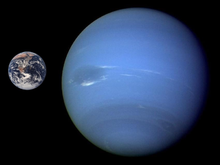Earth mass: Difference between revisions
Content deleted Content added
No edit summary |
Changed Mass from incorrect 5.9722 or 23 to correct 5.9736 as found in scientific journal. |
||
| Line 1: | Line 1: | ||
[[File:Neptune Earth Comparison.png|thumb|The mass of the Earth compares to [[Neptune]] as the mass of Neptune compares to [[Jupiter]].]] |
[[File:Neptune Earth Comparison.png|thumb|The mass of the Earth compares to [[Neptune]] as the mass of Neptune compares to [[Jupiter]].]] |
||
'''Earth mass (M<sub>⊕</sub>)''' is the unit of [[mass]] equal to that of the [[Earth]]. 1 M<sub>⊕</sub> = 5. |
'''Earth mass (M<sub>⊕</sub>)''' is the unit of [[mass]] equal to that of the [[Earth]]. 1 M<sub>⊕</sub> = 5.9736 × 10<sup>24</sup> [[kilogram|kg]].<ref name="jupfact"/><ref name="earth-sse">{{cite web |url=http://solarsystem.nasa.gov/planets/profile.cfm?Object=Earth&Display=Facts |title=Solar System Exploration: Earth: Facts & Figures |work=NASA |date=14 Feb 2011 |accessdate=2011-05-05}}</ref> Earth mass is often used to describe masses of rocky [[terrestrial planet]]s. |
||
The four [[terrestrial planet]]s of the [[Solar System]], [[Mercury (planet)|Mercury]], [[Venus]], [[Earth]], and [[Mars]], have masses of 0.055, 0.815, 1.000, and 0.107 Earth masses respectively. |
The four [[terrestrial planet]]s of the [[Solar System]], [[Mercury (planet)|Mercury]], [[Venus]], [[Earth]], and [[Mars]], have masses of 0.055, 0.815, 1.000, and 0.107 Earth masses respectively. |
||
Revision as of 16:57, 4 January 2013

Earth mass (M⊕) is the unit of mass equal to that of the Earth. 1 M⊕ = 5.9736 × 1024 kg.[1][2] Earth mass is often used to describe masses of rocky terrestrial planets.
The four terrestrial planets of the Solar System, Mercury, Venus, Earth, and Mars, have masses of 0.055, 0.815, 1.000, and 0.107 Earth masses respectively.
One Earth mass can be converted to related units:
- 81.3 Lunar mass (ML)
- 0.00315 Jupiter mass (MJ) (Jupiter has 317.83 Earth masses)[1]
- 0.0105 Saturn mass (Saturn has 95.16 Earth masses)[3]
- 0.0583 Neptune mass (Neptune has 17.147 Earth masses)[4]
- 0.000 003 003 Solar mass (M☉) (The Sun has 332946 Earth masses)
See also
References
- ^ a b Williams, Dr. David R. (02 November 2007). "Jupiter Fact Sheet". NASA. Retrieved 2009-07-16.
{{cite web}}: Check date values in:|date=(help) - ^ "Solar System Exploration: Earth: Facts & Figures". NASA. 14 Feb 2011. Retrieved 2011-05-05.
- ^ "Solar System Exploration: Saturn: Facts & Figures". NASA. 28 Jul 2009. Retrieved 2009-09-20.
- ^ "Solar System Exploration: Neptune: Facts & Figures". NASA. 5 Jan 2009. Retrieved 2009-09-20.
